VERY RARE! 1944 B-17 "OLD BATTLE AXE" WWII 8th Air Force 91st Bomb Group Sgt. Millard H. Rader (Flight Engineer/Top Turret Gunner) - Target Germany Air Medal and Citation

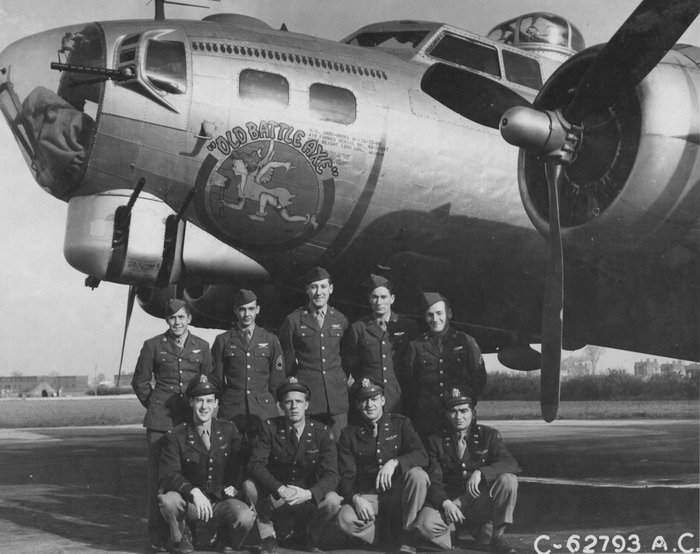
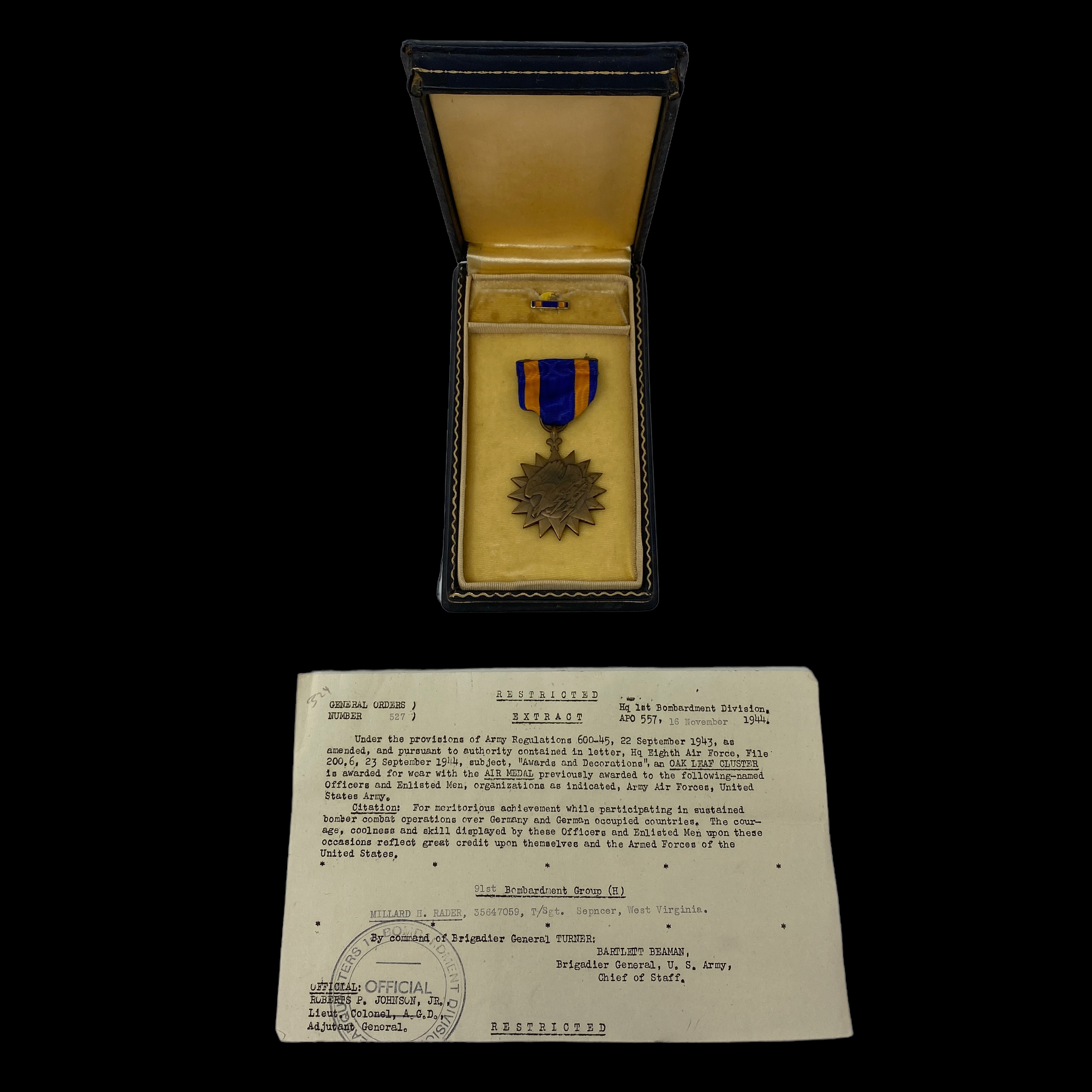
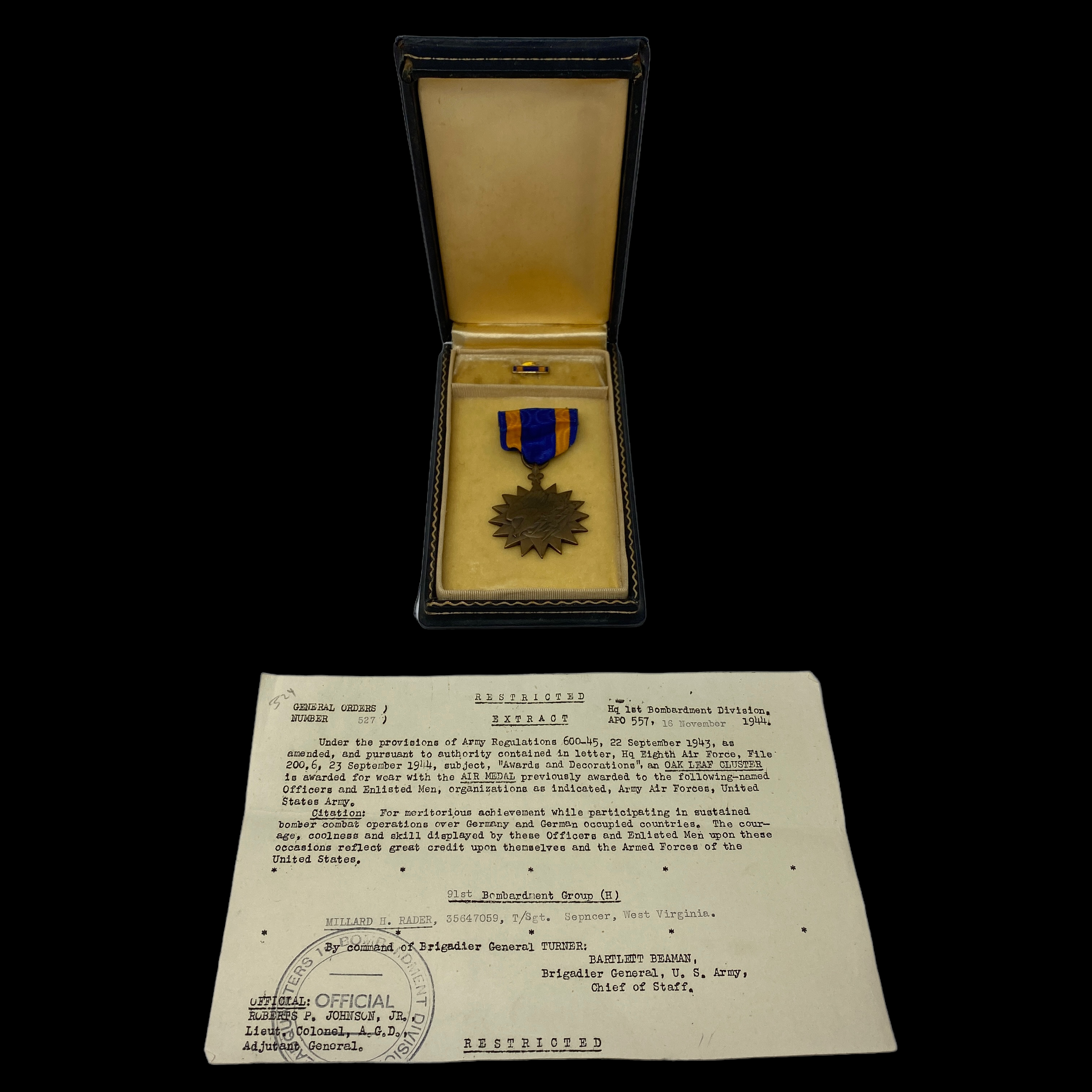

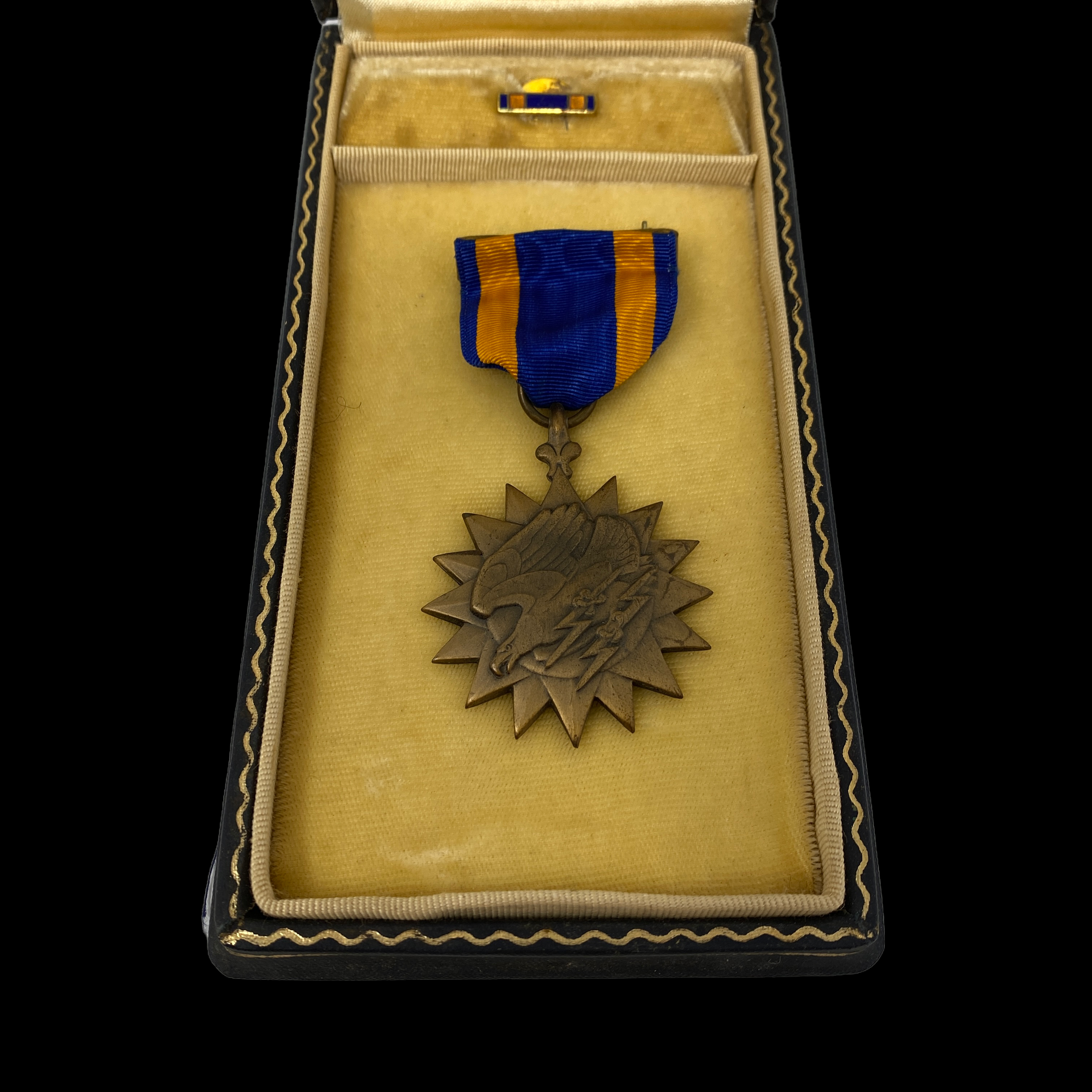
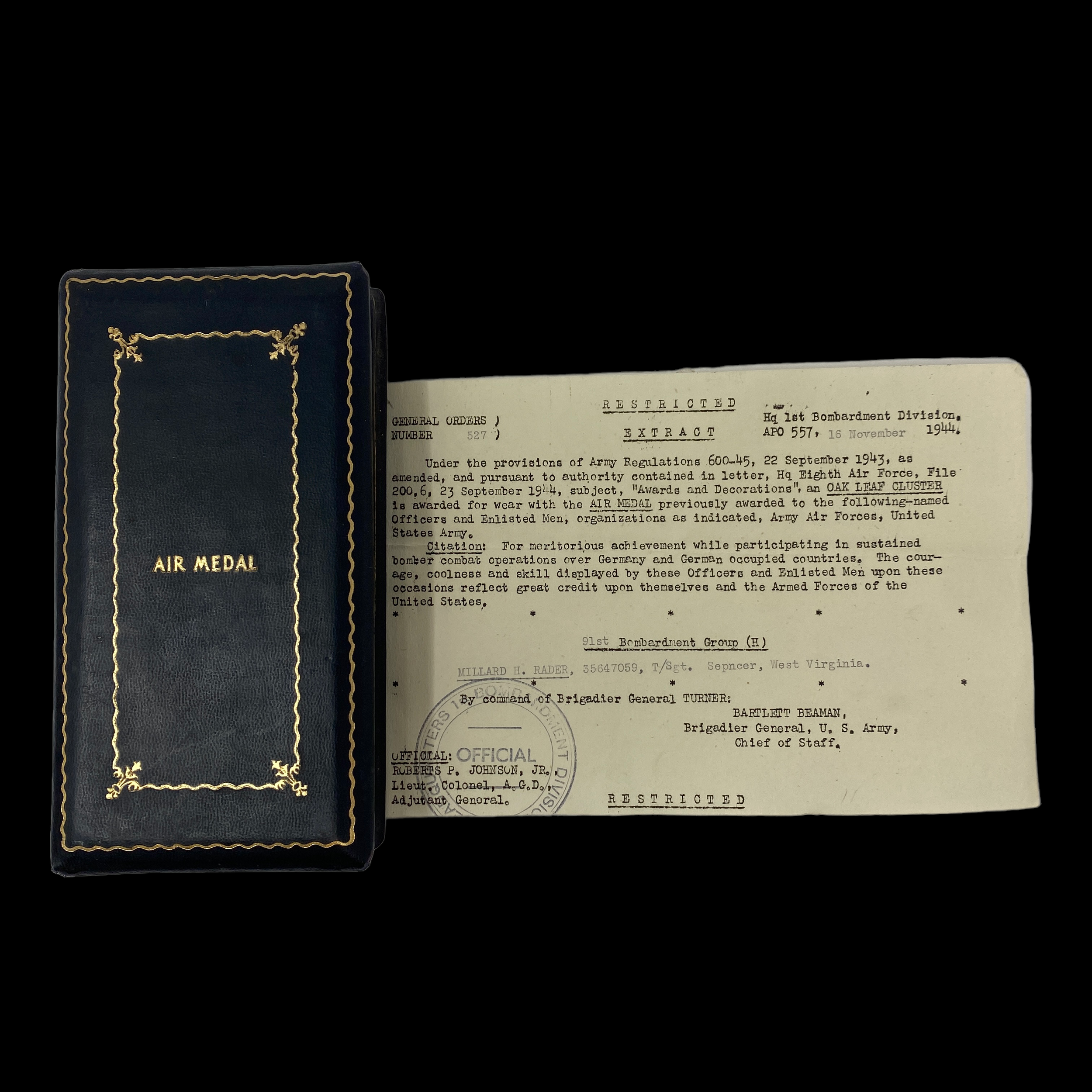
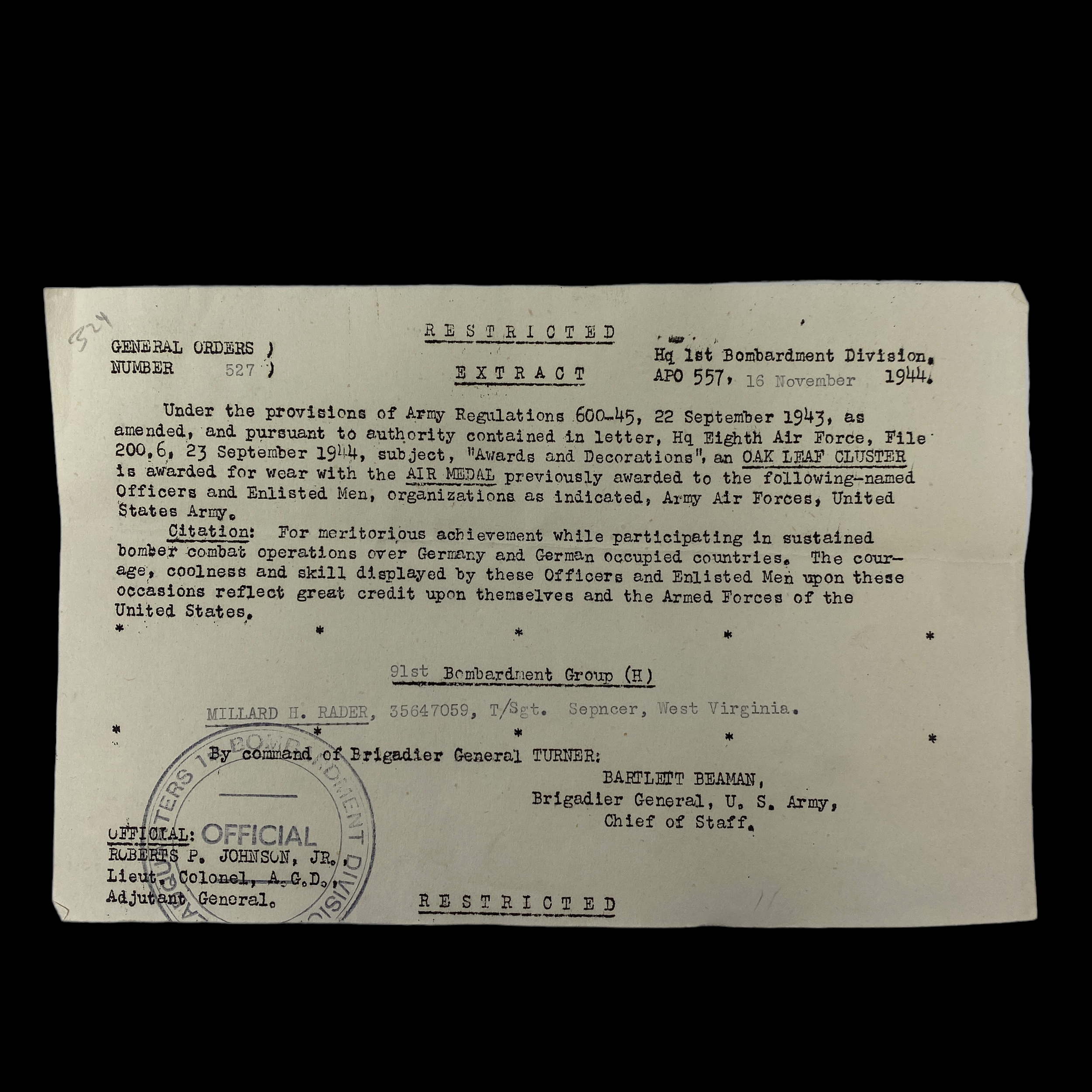
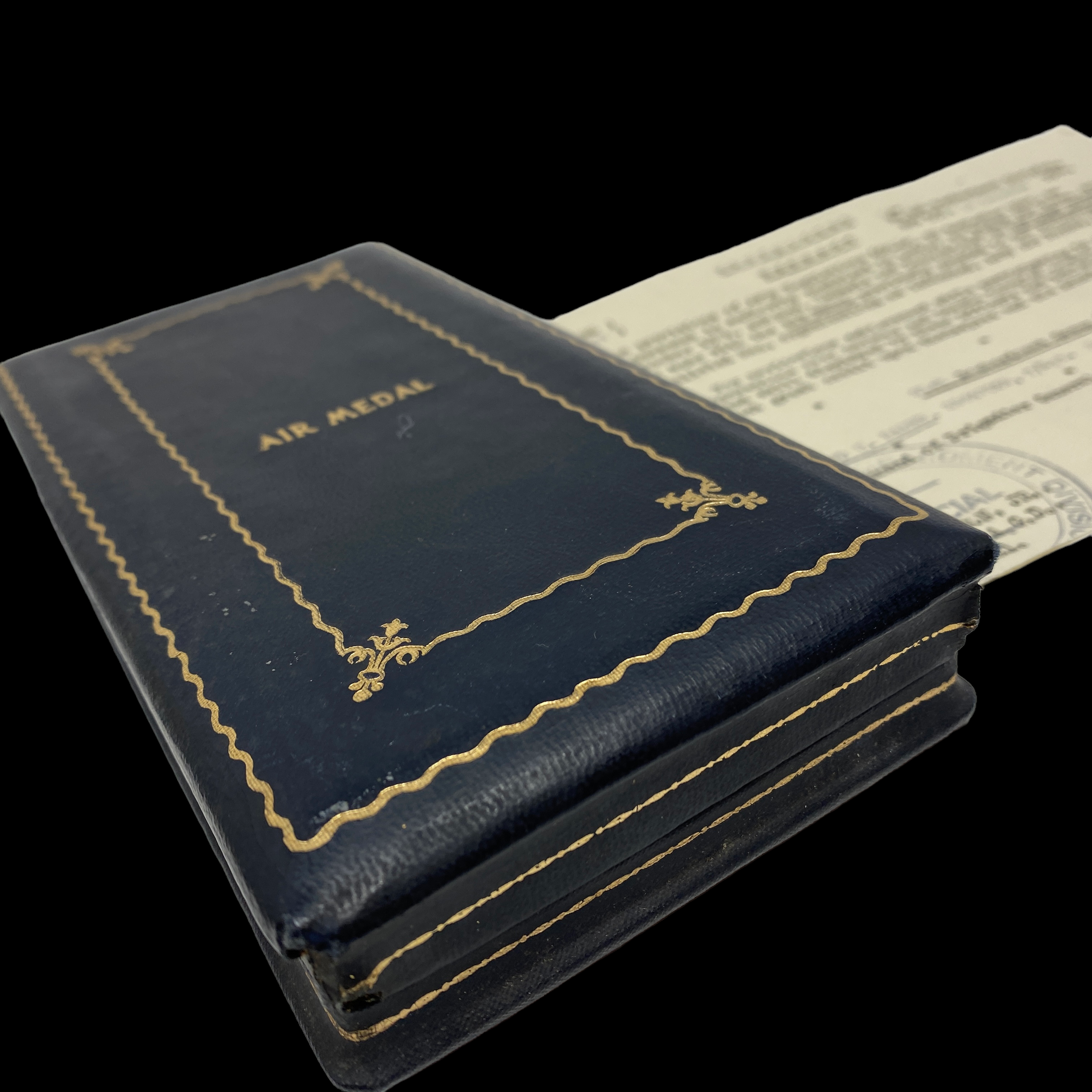
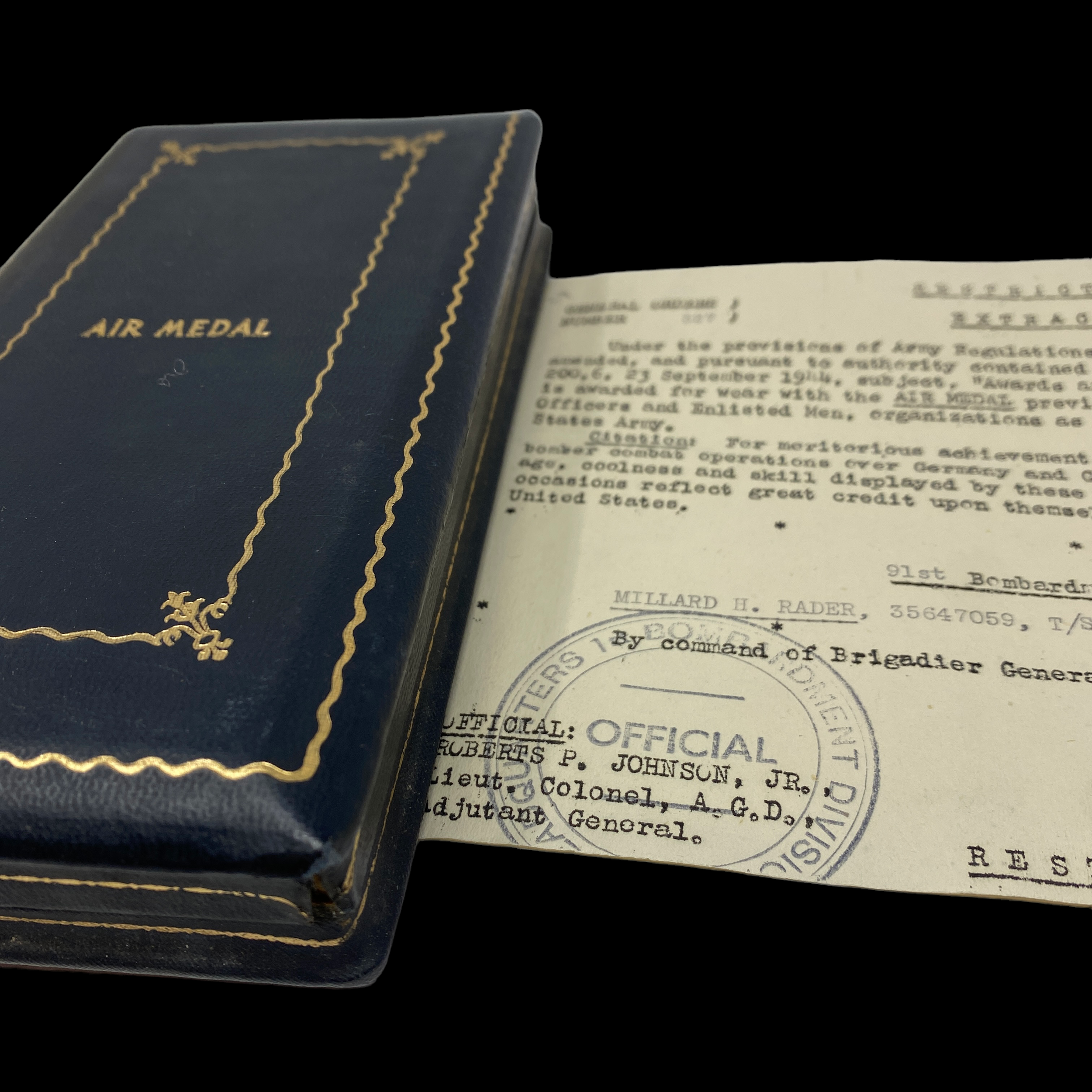
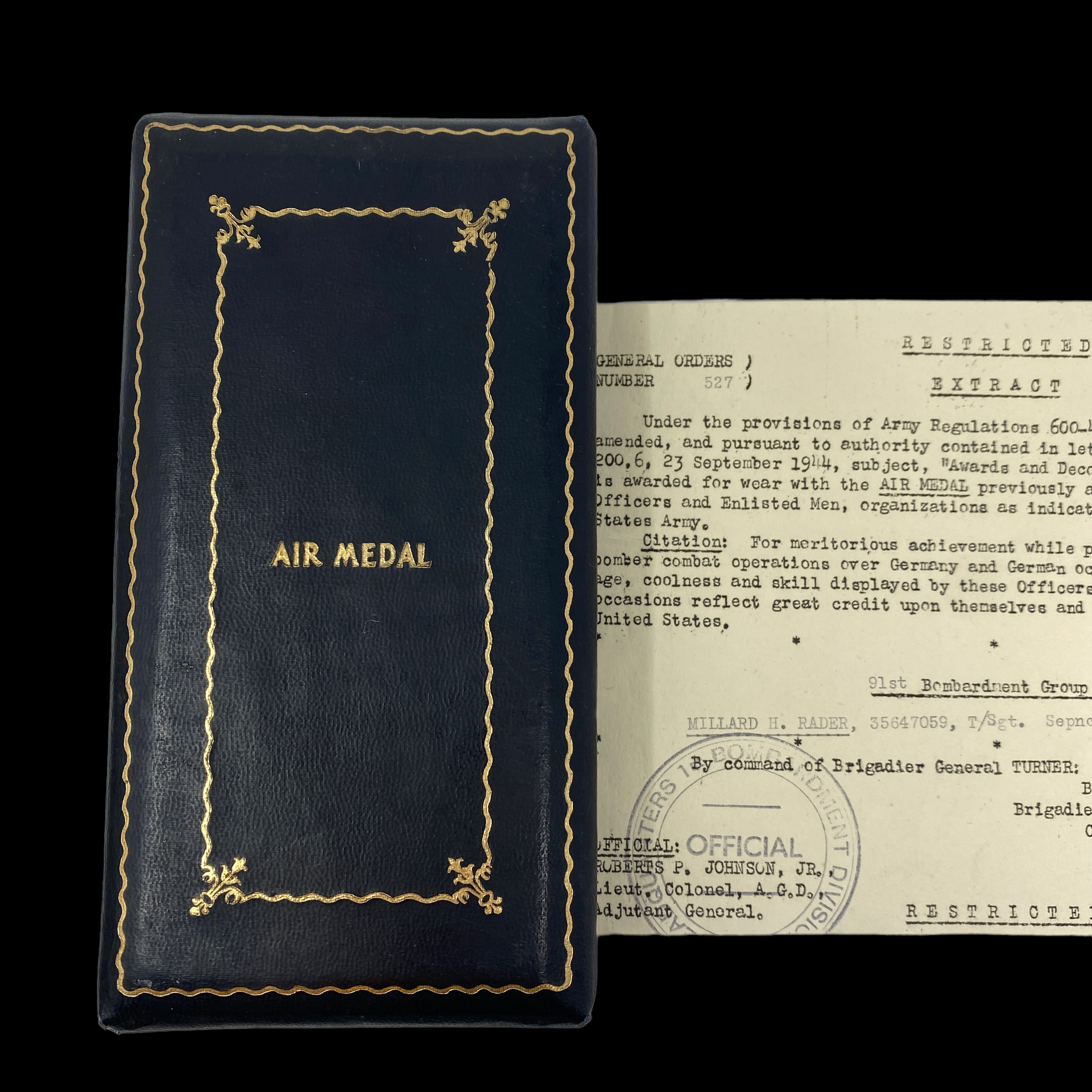
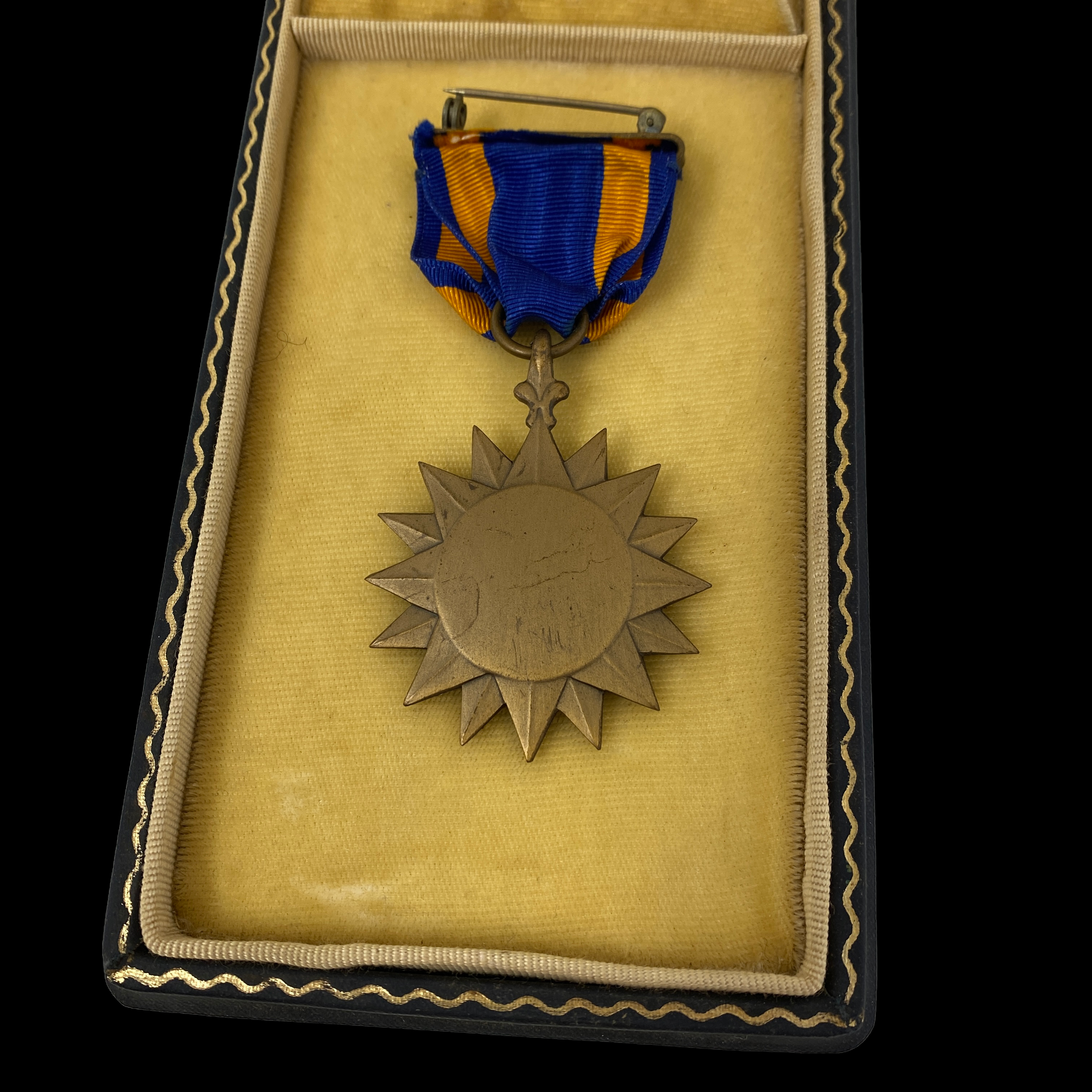
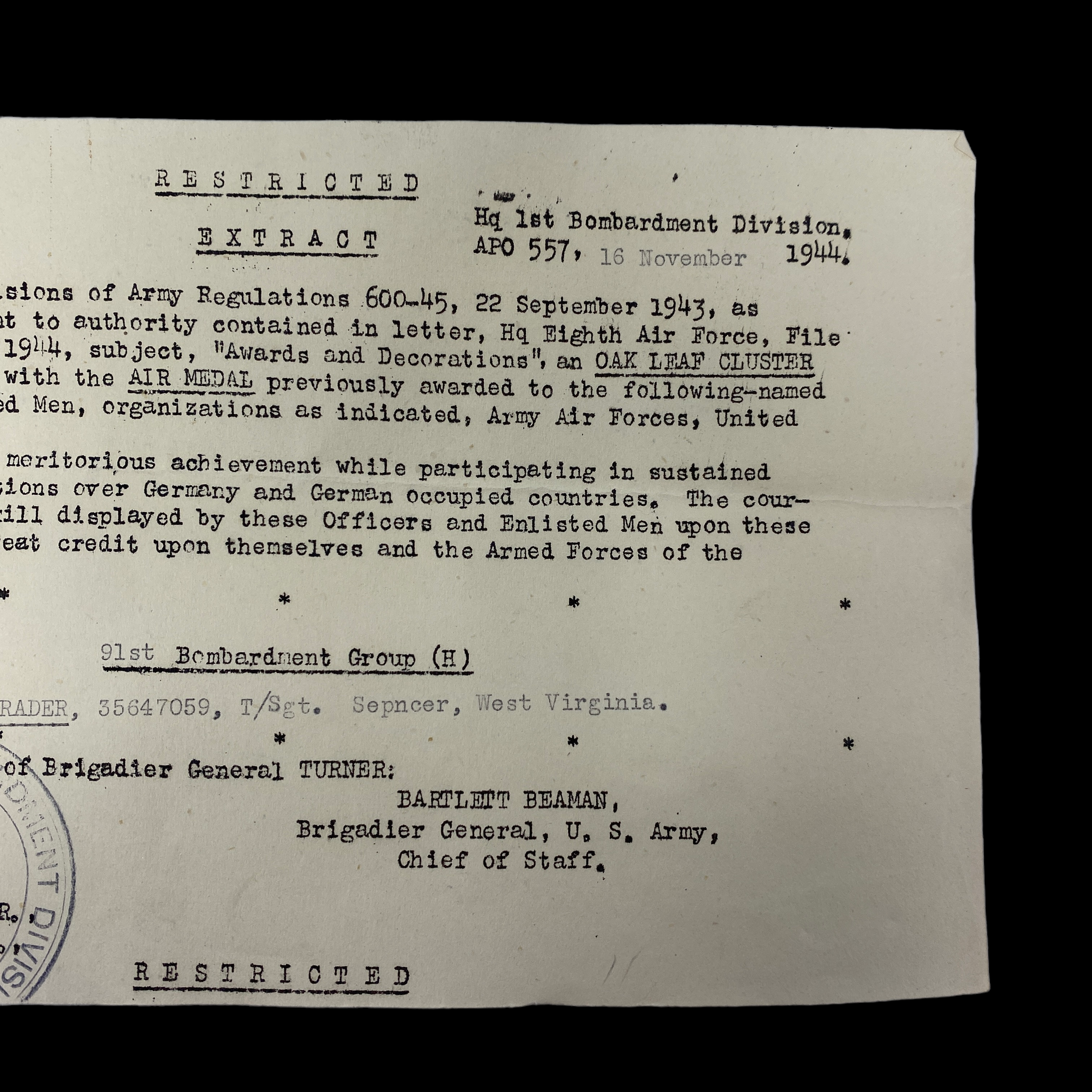

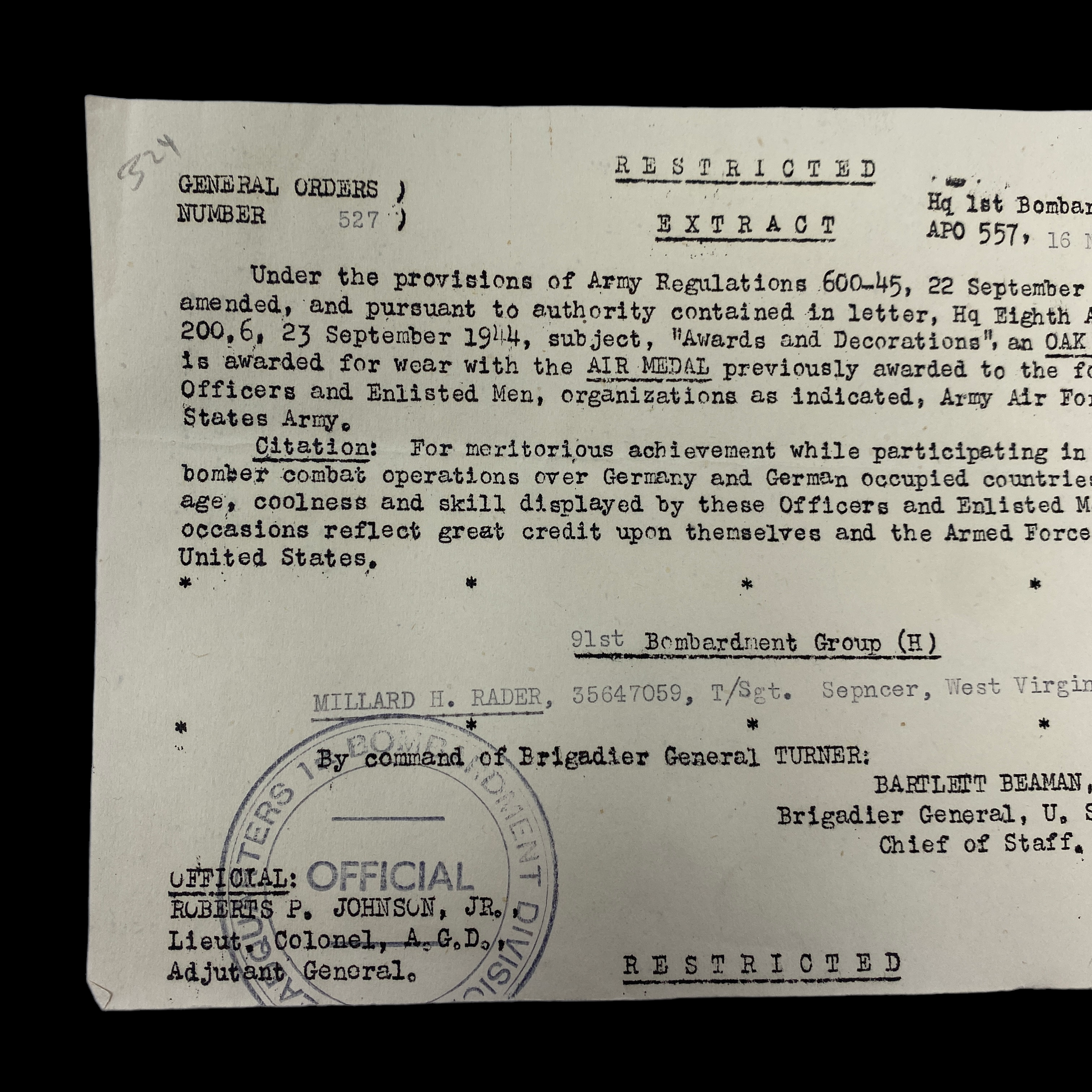

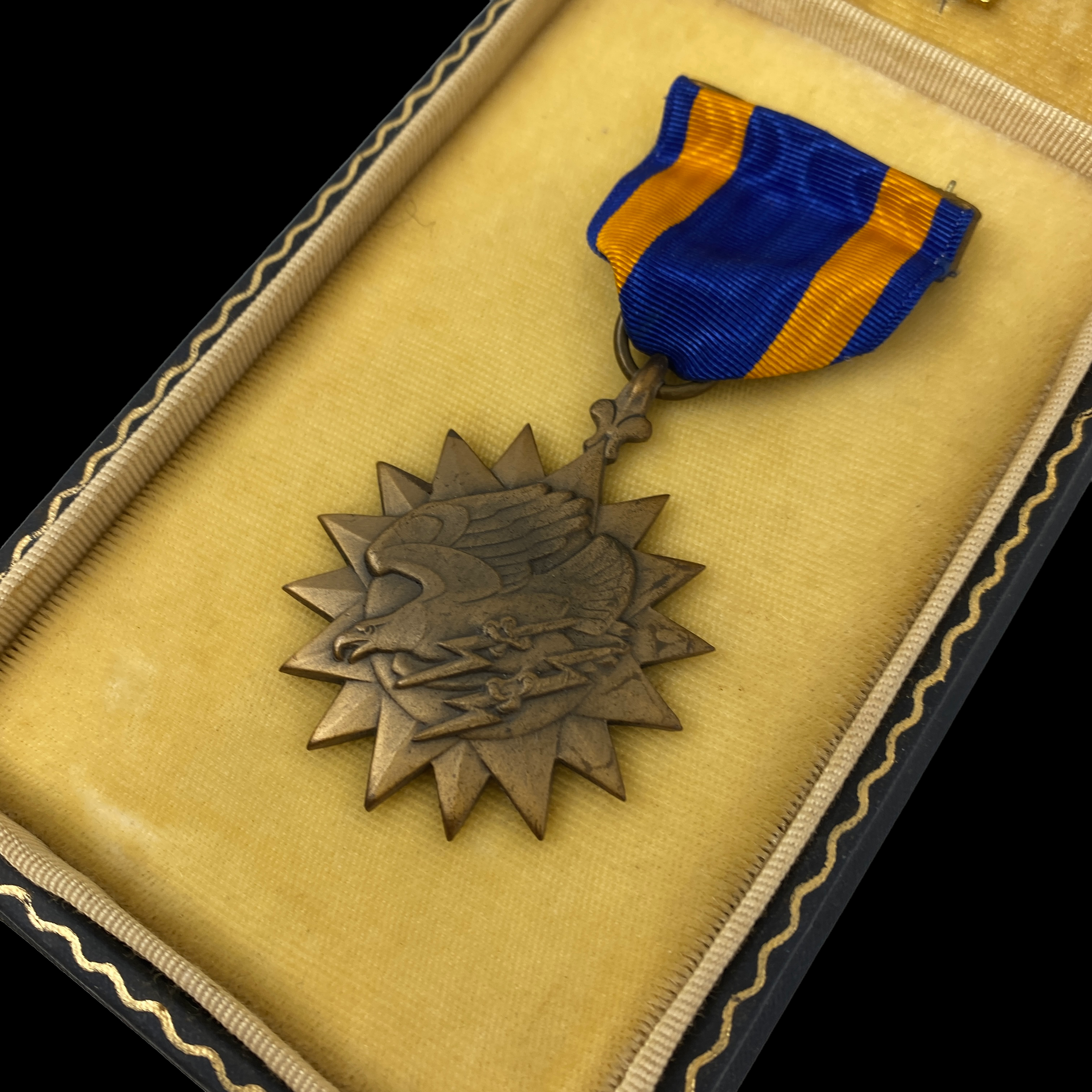
VERY RARE! 1944 B-17 "OLD BATTLE AXE" WWII 8th Air Force 91st Bomb Group Sgt. Millard H. Rader (Flight Engineer/Top Turret Gunner) - Target Germany Air Medal and Citation
Comes with hand-signed C.O.A.
*Fortresses of the 91st Bombardment Group bombed the submarine construction and repair centers at Kiel, Vegasack, Wilhelmshaven, Brest, Emden, Lorient, St. Nazaire, and La Pallice. They attacked railroad communications centers at Hamm, Bremen, Abbeville, and Rouen. At Antwerp the 91st hit the Erla Auto-Works and the former factories of Ford and General Motors; near Paris it bombed the great Renault tank and truck plant, and at Lille it attacked the steel and locomotive plants. At Bremen the Group smashed a Focke-Wulf factory, at Meaulte an aircraft repair base, and at Romilly-sur-Seine an airpark and airdrome. Many of these targets were raided more than once--St. Nazaire was hit by the 91st Group nine times. With the invasion of the continent successful, the 91st not only continued striking strategic targets but used its outstanding precision bombing skill on tactical targets in support of ground troops. As one of the first heavy bombardment organizations located in England in the early days of World War II, it had to learn techniques and tactics through experimentation, and frequently suffered heavy losses until it had mastered such lessons.
This incredible and museum-grade WWII Air Medal and original award citation were awarded to Sgt. Millard H. Rader (35647059) of the 8th Air Force 91st Bombardment Group while serving in the European Theater. This AIR MEDAL was awarded to Sgt. Millard H. Rader (B-17 Flight Engineer/Top Turret Gunner) for, “Meritorious achievement while participating in sustained bomber combat operations over Germany and German-occupied countries.”
This AIR MEDAL was awarded to Sgt. Millard H. Rader while flying on the B-17 named “OLD BATTLE AXE”. Over the course of WWII OLD BATTLE AX is accredited with 35 bombing raid combat missions in the ETO.
"Old Battle Axe" survived the war and was flown back to the USA in June 1945.
*SEE ATTACHED DIGITAL RECORDS OF THE DOCUMENTED FORTRESS.
The 91st Bomb Group (Heavy) was an air combat unit of the United States Army Air Forces during the Second World War. Classified as a heavy bombardment group, the 91st operated B-17 Flying Fortress aircraft and was known unofficially as "The Ragged Irregulars" or as "Wray's Ragged Irregulars", after the commander who took the group to England.
During its service in World War II the unit consisted of the 322nd, 323rd, 324th, and 401st Bomb Squadrons. The 91st Bomb Group is most noted as the unit in which the bomber Memphis Belle flew, and for having suffered the greatest number of losses of any heavy bomb group in World War II.
The 91st Bomb Group conducted 340 bombing missions with the Eighth Air Force over Europe, operating out of RAF Bassingbourn.
Comprehensive History of the 8th Air Force - 91st Bombardment Group During WWII:
The 91st Group, an element of the Eighth Air Force, entered combat on 7 November, when it attacked submarine bases at Brest, France. In order to move the huge amounts of men, supplies and equipment from the United Kingdom to North Africa, it was necessary to protect the movement from both submarine and aircraft attack. Accordingly the Eighth Air Force was required, as a matter of first priority, to attack the submarine bases on the west coast of France from which the major portion of the German U-boat fleet operated: Lorient, St. Nazaire, Brest, La Pallice, and Bordeaux. By the end of November the Group had flown seven more missions, six of which hit the submarine pens. Due to heavy cloud coverage, no bombs were dropped during a mission to Lorient on 22 November. A raid against the submarine pens at St. Nazaire on 23 November was disastrous; the 91st lost squadron commanders of the 322d and 324th, the group navigator, the group bombardier, and the group gunnery officer.
Consistently poor weather so badly hampered air operations throughout December 1942 that the 91st flew but four missions. On 20 December the 91st Group participated with the Eighth Air Force in a relatively large-scale mission against the aircraft park and repair depot at Romilly-sur-Seine. Results of the mission--the one effective attack made on the German Air Force during December--were reasonably good. Damage was inflicted on hangars, barracks, aircraft, and the landing ground. Of considerably greater historic significance, however, was the fact that, in the course of this deepest penetration yet made by the USAF planes into German-occupied territory, the bombers made contact with almost the entire force of enemy fighters located in northeast France. The ensuing air battle developed epic proportions and provided an important test of the US heavy bombers' ability to carry out unescorted missions deep into enemy territory. The fighter escort for the bombers had barely turned back for England when an estimated 60 enemy fighters launched an attack which continued almost to the target, when they were relieved by 50 to 60 fresh enemy fighters. On the return trip the bomber formation suffered almost continuous attack from the enemy fighters, most of which had apparently taken part in the earlier stages of the engagement and were now making second sorties. The 91st Group lost two aircraft while several more were badly holed by enemy fighter fire. Disaster hit the 91st on 30 December when the commanding officers of the 401st squadron and his crew were reported missing on a mission to the submarine bases at Lorient.
In the early months of 1943 operations were badly hampered by a continuation of bad weather. The 91st was alerted, briefed and standing by, only to have mission after mission canceled prior to take-off time or shortly after the unit became airborne. If the weather cleared at all, practice missions were flown. During January four missions were accomplished, in March nine, while during April when the weather again worsened, four. The submarine pens and submarine base facilities continued as primary targets, while aircraft factories, locomotive works, and communications were hit from time to time.
The outstanding mission of the period was a strike on the railway station and marshalling yards at Hamm, Germany, on 4 March. These yards were the largest and most important, carrying eastbound traffic from the Rurh. Yard capacity was 10,000 wagons in 24 hours as compared to a 3,000 wagon capacity of the medium-sized marshalling yards. The Eighth Air Force four-group formation was led by the 91st Group. Heavy overcast and cloud formations forced two of the groups to turn south and bomb Rotterdam, a last resort target. The third group returned to its base with bombloads intact. The 91st flew on alone; weather conditions improved slightly, although haze reduced visibility. Smoke partially obscured the target, but the objective was bombed in accordance with the briefed instructions. Results were excellent: direct hits were scored on station, buildings, locomotive engine sheds, main tracks and platforms, marshalling yards, and industrial buildings grouped in the vicinity. The combat crews thought that it was one of the "prettiest jobs of bombing" accomplished in the 22 missions the Group had flown up to that time. The 91st Bombardment Group was awarded a Presidential Citation for this action.
Eighteen months later, Target Germany, an official publication of the Eighth Air Force, stated that this raid, flown without fighter escort or supporting fire from other bombing formations, had convinced doubting officials in Washington. The prior belief had been that in a theater as strongly defended as the skies over Germany and in a climate where weather conditions provided so many obstacles, high altitude precision daylight was unsound and would lead to a high rate of loss in trained manpower and equipment. But the strike against Hamm was not achieved without loss. Four Flying Fortresses failed to return, and practically all of the other twelve aircraft making the strike suffered major damage.
The high altitude daylight missions which followed enabled the 91st Group to improve its precision bombing. On 18 March the submarine building yards at Vegasack were hit; strike photos brought back by combat crews indicated that not a bomb dropped by the 91st was wasted. Four days later the 91st, flying lead position of the 1st Bombardment Wing, attacked the pocket battleship Admiral Sheer and harbor installations at Wilhelmshaven. Although harassed by enemy fighters and accurate anti-aircraft fire, the Group completed its bomb run before being forced to take evasive action. No direct hit was reported on the battleship, but severe damage was inflicted on the harbor facilities. Nine of the twenty-one aircraft of the 91st sustained major battle damage, and the Group was officially credited with five enemy aircraft destroyed, one probably destroyed, and one known to have been damaged.
The 91st, flying lead position in a raid on the Focke-Wulf aircraft factory in Bremen on 17 April, inflicted major damage on the target, losing six aircraft in the action. Returning planes were damaged to the extent that the following day's mission was cancelled when it was found that sufficient aircraft could not become airborne in time.
By August, when the organization completed its first year of combat operations, 70 missions had been accomplished, although over 130 missions had been planned and briefed. Unfavorable weather hampered operations during the summer, but several missions were outstanding. On 22 June the 91st flew lead position for the VIII Bomber Command's strike on the synthetic rubber plant at Huls, Germany. This was the deepest penetration the unit had yet made into enemy territory. Enemy fighter and anti-aircraft fire were concentrated on the 91st Group, which lost five aircraft in the action. The unit was officially credited with nine enemy aircraft destroyed, two probably destroyed, and four damaged. Three days later, a mission to Hamburg was so hampered by adverse weather that neither the primary nor the secondary targets could be bombed, and the organization made its bomb run on Emden and a nearby airfield. It could not tell how effectual were the results for the target was completely obscured by clouds. During July ten missions were accomplished, one more than the 91st had previously flown in any month. During August several missions were below standard, but the one to Schweinfurt, Germany on the 17th brought many commendations to the 91st Group. This deep penetration mission required the organization to spend more time over enemy territory than any previous mission. The VIII Bomber Command was attacked by an estimated 300 enemy fighters as it flew over the coast of the mainland and approached Antwerp. The attack continued in intermittent waves all the way to the target, and from the target all the way back to the English Channel. Ten of the nineteen planes sent out by the 91st failed to return. Bomb damage to the ball bearing works was extensive and direct hits were made on the factory proper, the power house, two machine shops, a large office building, several storage sheds, rail-road sidings, and freight cars. Two days later, when another mission was assigned, the 91st had seven flyable planes, but ground crews worked all night and had another plane ready for the mission in the morning. The 381st Group, which had lost 11 aircraft in the Schweinfurt raid, joined the 91st in putting 15 planes up for the strike on an airdrome at Gilse Rijen.
One of the most outstanding examples of precision bombing during the was occurred on 9 October, when the 91st Group almost completely destroyed the Focke-Wulf factory at Anklem. Clouds of smoke from raging fires were reported rising to 20,000 feet. As a result of continuous and vicious attacks by enemy fighters and accurate and intense flack, five of the 91st's planes failed to return and the rest of the Group's planes which took part in the mission were damaged severely. Schweinfurt's ball bearing factories were hard hit again on 14 October, 1943, when many direct strikes caused major fires in the factory area. The 91st lost one plane and destroyed three enemy aircraft. Throughout the fall and winter months the 91st ranged over France and deep into Germany to bomb submarine bases, airdromes, industrial installations, marshalling yards, and port facilities.
On 5 January the 91st Group attacked Tours, France, and claimed it was the first bombardment group in the European Theater of Operations to complete 100 missions. Adverse weather conditions, so prevalent throughout most of 1943, continued to hamper operations. Of the 16 missions for which the Group became airborne, only 8 were completed. The outstanding mission of the period occurred on 11 January 1944, when the 91st's B-17s hit and extensively damaged the Focke-Wulf plant at Oschersleben, Germany. Enemy fighter action was aggressively persistent; four of the B-17s were shot down on the flight to the target, and one more B-17 was lost over the target. Out of the 210 enemy aircraft destroyed on this strike made by the 1st Bombardment Division, the 91st was officially credited with 38. The Group shared the Presidential Unit Citation awarded to the Division for the action.
Not until March did weather improve, and with better weather the bombardment groups went into all-out action. The 91st participated in 15 missions, the greatest number yet accomplished during any month of its combat operations. On 3 March the Group set out to strike Berlin for the first time, but the attack had to be abandoned because of the weather, and Wilhelmshaven was bombed with unseen results. On 4 March the weather again caused the cancellation of the scheduled Berlin strike, and bombs were dropped on Cologne. Not until 22 March was Berlin bombed by the 91st Group.
Early in June 1944 the 91st Group was assigned tactical targets for the first time. On 2, 3, 4, and 5 June it hit gun emplacements and troop concentrations in the Cherbourg area. On D-Day, 6 June, 36 aircraft of the 91st bombed gun positions at La Riveria, knocking out many of the batteries that otherwise would have concentrated firepower on the troops making the beachhead landings. On 22 June the Eighth and Fifteenth Airforce used all available aircraft--2,000 bombers--in the heaviest daylight assault yet made on Berlin. By the end of the month the 91st Group had completed 22 missions, the top monthly record for the 91st to this time.
On 19 July 1944 the 91st Group flew its 200th mission, a strike on the airdrome at Lechfeld. In a mission to Leipsig the following day, the 91st inflicted serious damage on enemy installations but lost eight of its B-17s. On 24 and 25 July it flew tactical missions in support of ground troops in the St. Lo sector, bombing enemy troop positions designated by the pilot of a low-flying Piper Cub which belonged to the artillery unit the 91st was assigned to support.
During August, as in May, the 91st flew 19 missions; the most outstanding being the strike on 16 August, when the Group's excellent precision bombing literally flattened the aircraft factory at Halle. Six aircraft, all from the 324th squadron, were lost on this raid. Only on one other mission had the losses been from one squadron--the 401st had lost six aircraft in the strike against the Focke-Wulf airplane factory at Bremen on 17 April 1943. By the end of the month the 91st Group had completed 11 raids over Berlin.
The 91st Group dropped propaganda leaflets for the first time on 3 September, when five aircraft dropped leaflets over Karlsruhe, Saarbrucken, Neunkerchen, Hamburg, Mains, Speyer, Mannheim, Framkenthal, Luxembourg, and Trier. Other targets assigned during September, October, and November were airfields, factories, marshalling yards, and oil facilities. As weather worsened, bombing was accomplished by PFF (Pathfinder Force); during November 1944 only one out of 11 missions was visual. On 3 November the Group struck what was then considered the toughest target--the synthetic oil facilities at Merseburg. Although the precision bombing was superb and resulted in extensive and severe damage, the raid was disastrous for the 91st. The Group lost 15 aircraft and 14 crews--its greatest loss in a single mission during World War II.
During December 1944 the 91st Group struck 10 different targets in 11 raids ranging from strategic attacks on marshalling yards and oil centers to tactical attacks on communications centers in support of the Allied armies engaged in the Battle of the Bulge. Cologne was hit four times during January 1945. On 3 February the Allied air forces concentrated its air power on all-out onslaught against Berlin. At one time during the day, bombers stretched all the way from the Dutch frontier to Berlin, 300 miles away. The preceding night the RAF had used 1,000 heavy bombers against troop concentrations at Weisbaden, Karlsruhe, Mannheim, and Magdeburg and the synthetic oil plant at Wanne-Erekel in the Ruhr sector; and Russian forces had struck Germany from the East.
Concentrated attacks of the Allied Forces on 22 February were aimed at covering all secondary rail systems in the hope of completely disrupting German rail traffic. The 91st's target was the rail center at Stendal. More than 6,000 aircraft on the Eighth, Ninth, Fifteenth, and Second Tactical Air Forces, and the United Kingdom's RAF cooperated in the effort. The heavy and medium bombers dumped tons of high explosives on rail facilities and bridges, while Allied fighter planes flew the deck strafing every moving means of transportation from motor convoys and bicycles to row boats.
During March the 91st Group equaled its Kune 1944 record of 22 missions, hitting targets both strategic and tactical. The latter, flown in support of the Allied push across the Rhine, hit bridges, rail systems, and airfields. On 24 March the 91st flew two missions in support of the actual Rhine crossing.
Fifteen strikes were made between 1 and 25 April: eight hits on rail communications, six against airfields, two on ordnance depots, one against an underground oil depot, and one on a heavily defended area near Royan on the Gironde River. The Group's last offensive mission--its 340th--was flown on 25 April against Pilsen. In May the 91st flew four missions to evacuate 2,454 prisoners of war from Linz and Barth airdromes.
Alerted for early redeployment to the United States and later reassignment to the Pacific Theater of Operations, the 91st Group sailed aboard the Queen Elizabeth on 25 June and docked at New York City five days later. The organization moved to Drew Field, Tampa, Florida, for a period of retraining, which came to an end with the cessation of hostilities in the Pacific. On 7 November 1945 the 91st Bombardment Group was inactivated.